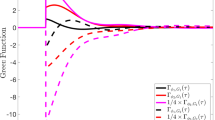Abstract
The recently developed short-time linear response algorithm, which predicts the average response of a nonlinear chaotic system with forcing and dissipation to small external perturbation, generally yields high precision of the response prediction, although suffers from numerical instability for long response times due to positive Lyapunov exponents. However, in the case of stochastically driven dynamics, one typically resorts to the classical fluctuation-dissipation formula, which has the drawback of explicitly requiring the probability density of the statistical state together with its derivative for computation, which might not be available with sufficient precision in the case of complex dynamics (usually a Gaussian approximation is used). Here, we adapt the short-time linear response formula for stochastically driven dynamics, and observe that, for short and moderate response times before numerical instability develops, it is generally superior to the classical formula with Gaussian approximation for both the additive and multiplicative stochastic forcing. Additionally, a suitable blending with classical formula for longer response times eliminates numerical instability and provides an improved response prediction even for long response times.
Similar content being viewed by others
References
Abramov R. Short-time linear response with reduced-rank tangent map. Chin Ann Math, 2009, 30B(5): 447–462
Abramov R. Approximate linear response for slow variables of dynamics with explicit time scale separation. J Comput Phys, 2010, 229(20): 7739–7746
Abramov R, Majda A. Blended response algorithms for linear fluctuation-dissipation for complex nonlinear dynamical systems. Nonlinearity, 2007, 20: 2793–2821
Abramov R, Majda A. New approximations and tests of linear fluctuation-response for chaotic nonlinear forced-dissipative dynamical systems. J Nonlin Sci, 2008, 18(3): 303–341
Abramov R, Majda A. New algorithms for low frequency climate response. J Atmos Sci, 2009, 66: 286–309
Bell T. Climate sensitivity from fluctuation dissipation: Some simple model tests. J Atmos Sci, 1980, 37(8): 1700–1708
Carnevale G, Falcioni M, Isola S, Purini R, Vulpiani A. Fluctuation-response in systems with chaotic behavior. Phys Fluids A, 1991, 3(9): 2247–2254
Cohen B, Craig G. The response time of a convective cloud ensemble to a change in forcing. Quart J Roy Met Soc, 2004, 130(598): 933–944
Eckmann J, Ruelle D. Ergodic theory of chaos and strange attractors. Rev Mod Phys, 1985, 57(3): 617–656
Evans D, Morriss G. Statistical Mechanics of Nonequilibrium Liquids. New York: Academic Press, 1990
Gritsun A. Fluctuation-dissipation theorem on attractors of atmospheric models. Russ J Numer Math Modeling, 2001, 16(2): 115–133
Gritsun A, Branstator G. Climate response using a three-dimensional operator based on the fluctuation-dissipation theorem. J Atmos Sci, 2007, 64: 2558–2575
Gritsun A, Branstator G, Dymnikov V. Construction of the linear response operator of an atmospheric general circulation model to small external forcing. Num Anal Math Modeling, 2002, 17: 399–416
Gritsun A, Branstator G, Majda A. Climate response of linear and quadratic functionals using the fluctuation dissipation theorem. J Atmos Sci, 2008, 65: 2824–2841
Gritsun A, Dymnikov V. Barotropic atmosphere response to small external actions, theory and numerical experiments. Atmos Ocean Phys, 1999, 35(5): 511–525
Kubo R, Toda M, Hashitsume N. Statistical Physics II: Nonequilibrium Statistical Mechanics. New York: Springer-Verlag, 1985
Kunita H. Stochastic Flows and Stochastic Differential Equations. Cambridge: Cambridge University Press, 1997
Leith C. Climate response and fluctuation-dissipation. J Atmos Sci, 1975, 32: 2022–2025
Lorenz E. Predictability—a problem partly solved. In: Palmer T, Hagedorn R, eds. Predictability of Weather and Climate. Cambridge: Cambridge University Press, 2006
Lorenz E, Emanuel K. Optimal sites for supplementary weather observations. J Atmos Sci, 1998, 55: 399–414
Majda A, Abramov R, Gershgorin B. High skill in low frequency climate response through fluctuation dissipation theorems despite structural instability. Proc Natl Acad Sci, 2010, 107(2): 581–586
Majda A, Abramov R, Grote M. Information Theory and Stochastics for Multiscale Nonlinear Systems. CRM Monograph Series of Centre de Recherches Mathématiques, Université de Montréal, Vol 25. Providence: American Mathematical Society, 2005
Majda A, Gershgorin B. A test model for fluctuation-dissipation theorems with timeperiodic statistics. Physica D, 2010, 239(17): 1741–1757
Majda A, Wang X. Linear response theory for statistical ensembles in complex systems with time-periodic forcing. Commun Math Sci, 2010, 8(1): 145–172
Risken F. The Fokker-Planck Equation. 2nd ed. New York: Springer-Verlag, 1989
Ruelle D. Chaotic Evolution and Strange Attractors. Cambridge: Cambridge University Press, 1989
Ruelle D. Differentiation of SRB states. Comm Math Phys, 1997, 187: 227–241
Ruelle D. General linear response formula in statistical mechanics, and the fluctuationdissipation theorem far from equilibrium. Phys Lett A, 1998, 245: 220–224
Young L-S. What are SRB measures, and which dynamical systems have them? J Stat Phys, 2002, 108(5–6): 733–754
Author information
Authors and Affiliations
Corresponding author
Rights and permissions
About this article
Cite this article
Abramov, R.V. Improved linear response for stochastically driven systems. Front. Math. China 7, 199–216 (2012). https://doi.org/10.1007/s11464-012-0192-7
Received:
Accepted:
Published:
Issue Date:
DOI: https://doi.org/10.1007/s11464-012-0192-7




